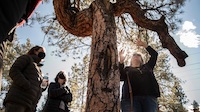- Forum
- Life Up the Hill
- Community News, Events, and Calendar
- Are these Colorado trees culturally modified..or just bent? Depends whom you ask
Are these Colorado trees culturally modified..or just bent? Depends whom you ask
- Mountain-News-Events
-
 Topic Author
Topic Author
- Mountain Legend
-

Less
More
04 Nov 2021 15:17 #1
by Mountain-News-Events
My Mountain Town Community Calendar - filter events by Category, date, or keyword to easily find events of interest. Add your community, church, or non-profit event to the calendar yourself! Click here to access the submission form. Businesses: please contact us for more information on adding your events! Questions? Email
Community News, Events, and Calendar Forum - Check here for the latest happenings in our community and add your own!
Are these Colorado trees culturally modified..or just bent? Depends whom you ask was created by Mountain-News-Events
Are these Colorado trees culturally modified… or just bent? Depends on whom you ask.
Some say Native Americans modified trees to mark sacred spots in the forest. But tribal leaders and Colorado archaeologists say neither oral tradition nor science back up the claim.
By Olivia Prentzel, The Colorado Sun
4:01 AM MDT on Oct 31, 2021
Some say Native Americans modified trees to mark sacred spots in the forest. But tribal leaders and Colorado archaeologists say neither oral tradition nor science back up the claim.
By Olivia Prentzel, The Colorado Sun
4:01 AM MDT on Oct 31, 2021
Janet Shown (right), vice president of NASTaP, or Association for Native American Sacred Trees and Places, leads a public tour of culturally modified trees on Sunday, Oct. 24, 2021, near Glen Isle Resort in Bailey. (Olivia Sun, The Colorado Sun)
BAILEY — Rooted on a former Ute encampment in the foothills of the Front Range, the piney crown of a long-lived ponderosa pine pokes nearly 100 feet into the sky. Its trunk, gnarled and knobbly with age, is hollowed at the bottom, offering what could be a narrow shelter for someone to hunt from. Higher up, there’s a peephole — just wide enough for an arrow — carved in the cinnamon-colored bark.
Before there were highway signs, trees served as natural signposts through the forest, marking important sites, such as water sources, sacred healing spots, hunting lookouts and birthing stations, Janet Shown, co-founder of The Association for Native American Sacred Trees and Places, said as she guided a group of curious people through the woods behind Glen Isle Resort in Bailey.
People are drawn to the unusually-shaped trees, known to some as culturally-modified trees or marker trees, and the tales some say they tell, yet they are entangled in controversy.
Marker trees dot the 160-acre property of Glen Isle, a former railroad depot that first opened in the early 1900s. The 120-year-old Adirondack-style lodge now serves as a resort off U.S. 285 and as a cultural hub for Native American artifacts.
My Mountain Town Community Calendar - filter events by Category, date, or keyword to easily find events of interest. Add your community, church, or non-profit event to the calendar yourself! Click here to access the submission form. Businesses: please contact us for more information on adding your events! Questions? Email
Community News, Events, and Calendar Forum - Check here for the latest happenings in our community and add your own!
Please Log in or Create an account to join the conversation.
- Forum
- Life Up the Hill
- Community News, Events, and Calendar
- Are these Colorado trees culturally modified..or just bent? Depends whom you ask
Time to create page: 0.139 seconds







